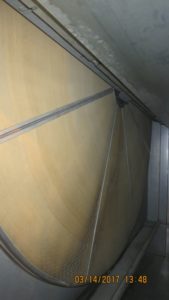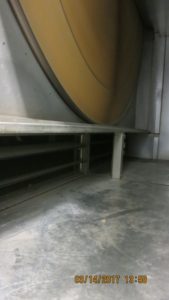- November 16, 2017
- 0 Comments
- In Existing Building Performance Occupant Health & Wellness
- By Steven Winter Associates

The International Energy Conservation Code (IECC) has a number of requirements involving energy recovery on ventilation systems. Requirements vary based on climate zone, building type and size, equipment capacity, and equipment operating hours. As a result, many new construction projects must now incorporate energy recovery considerations into their design.
An energy recovery unit (ERU) equipped with a heat wheel can be a great way to satisfy these energy recovery requirements. The ERU can be a roof-mounted air handling unit, or can be an air handling unit located inside a mechanical room with outdoor air and exhaust streams ducted in. The heat wheel is positioned so that half of the wheel sits in the exhaust air duct and the other half sits in the outdoor air intake duct. During cold weather, the wheel spins, transferring heat from the exhaust stream to the outdoor air intake stream. During hot weather, the wheel transfers heat from the outdoor air intake stream to the exhaust stream. In both cases the heat exchange enables the building to take advantage of the more comfortable conditions of the exhaust air, while still allowing fresh air to enter the building. During extreme weather conditions, heat wheels can save energy on space conditioning while still allowing for healthy indoor air quality.
What Could Go Wrong?
Heat wheels can provide a heat transfer effectiveness of 85% or greater. However, there are some common mistakes to avoid while configuring an ERU with a heat wheel.
At one retro-commissioning project, a large facility had four air handling units (AHUs) that provided 100% outdoor air, for a total of 84,000 CFM. These units were equipped with heat wheels, and the commissioning engineer on site described the set-up:
“As part of the design, the system is equipped with bypass dampers such that the incoming OA can avoid contact with the heat recovery wheel which is desirable when OA conditions are appropriate for economizer. However, during normal operation the dampers are designed to be closed and the air should pass through the recovery wheel. We discovered that although the dampers were functional they were being controlled in a reverse fashion. This resulted in recovery during economizer and no recovery during normal operation. Obviously, this has a significant impact on the heating and cooling energy consumed by each AHU and they were quick to make the correction at the BMS with their controls contractor. So they should experience massive savings for a very small investment.”
The heat recovery wheel was operating only when the outdoor air temperature was already at a comfortable temperature (economizer conditions). During hot and cold weather, when heat recovery is most effective, the outdoor air was bypassing the heat recovery wheel. Fortunately, the solution was a quick one, and the system was returned to its intended operation.

Heat wheel

Heat wheel with open bypass dampers
In another building, packaged ERUs with heat wheels were intended to be controlled using the building’s BMS. Facility staff noticed that the wheels were running 24/7 – even when outdoor air economizer would have been beneficial. If the temperature in the exhaust air stream is higher than the temperature in the outdoor air stream, but the building is still calling for cooling, the heat wheel has no need to run. Running the heat wheel under these conditions will only add to the cooling load required by the unit. Here, the correction was more difficult to make because some of the programming for the wheels’ sequence was buried in on-board packaged controllers, which require a manufacturer’s rep to alter. It should be noted that integrating packaged on-board controls with a central BMS can also present difficulties for many types of equipment- the problem is not unique to heat wheels.
Final Thoughts
While heat wheels can be energy saving tools, simply purchasing a wheel won’t provide energy savings. The savings lie in the wheel’s sequence of operations. In order for savings to be realized, the wheel must run only when the exhaust air conditions are closer to the supply air setpoints than the outdoor air conditions. Diligent testing during the commissioning process will weed out the common sequencing issues, and ensure that energy savings equipment performs as intended.

Written by Maria Rode, Mechanical Engineer
